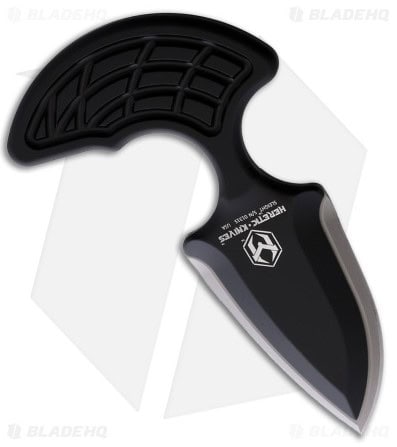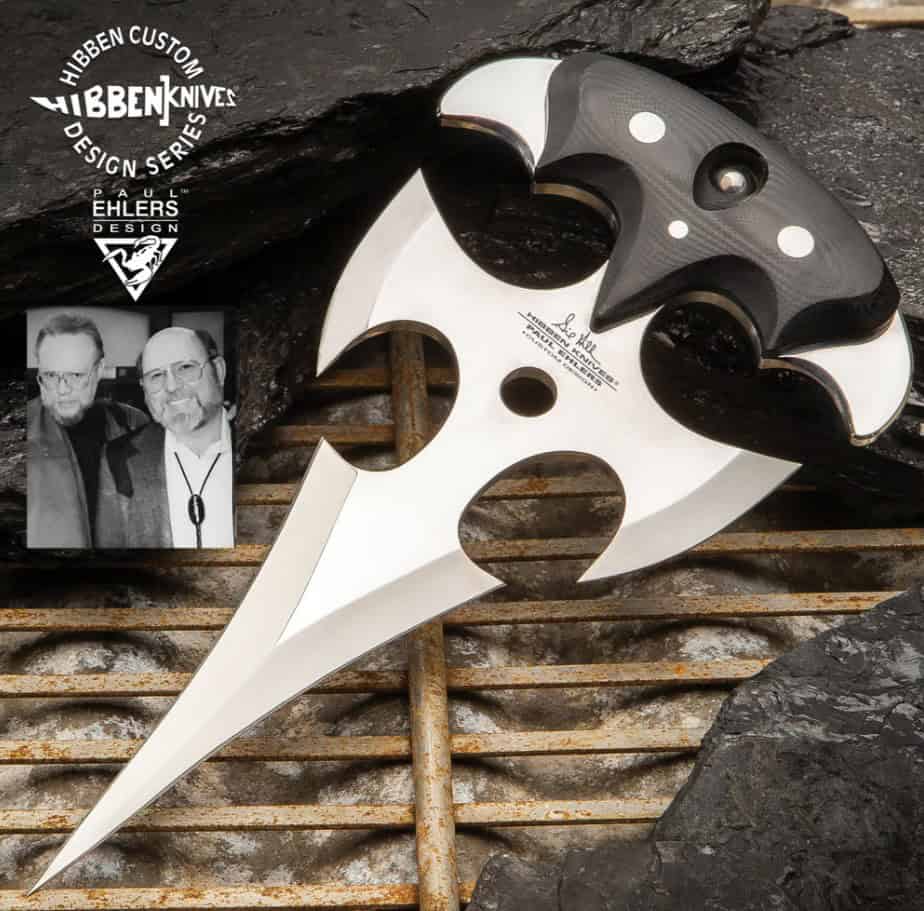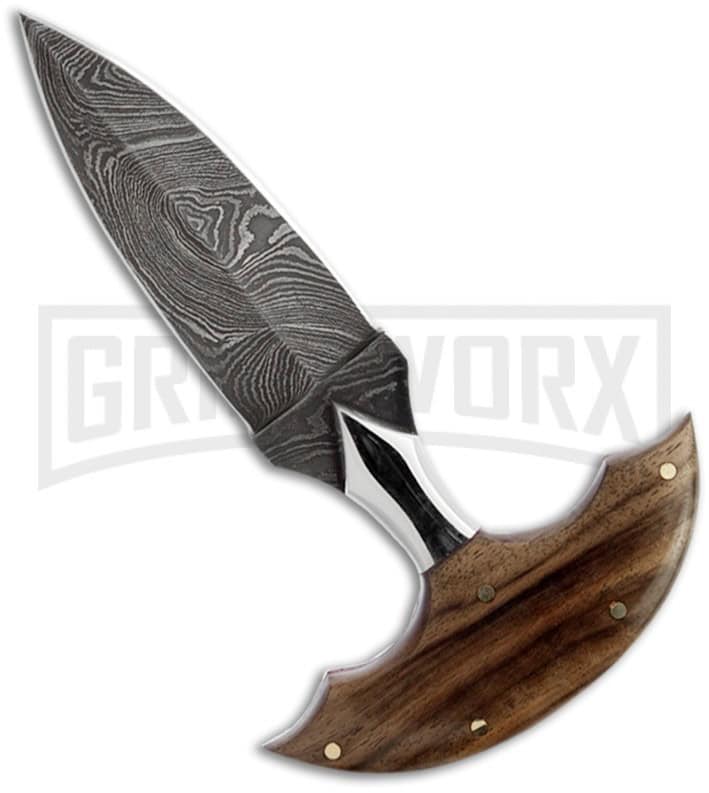What is a Push Dagger?
TLDR: A push dagger is a compact, T-handle knife designed to be gripped in the fist with the blade protruding between the fingers, used primarily for close-quarters self-defense.
When it comes to compact, concealable blades, push daggers are in a league of their own. I’ve always been fascinated by their unique design and versatility. These little powerhouses pack a serious punch in a small package, and I’ve got to say, they’re one of my favorite types of edged weapons.
Push daggers, with their T-shaped handle and blade extending from the fist, have a rich history dating back to the Indian Katar. In my opinion, they’re one of the most underappreciated weapons in the knife world. Sure, they might not be as flashy as a bowie knife or as practical as a Swiss Army knife, but for close-quarters self-defense, you’d be hard-pressed to find something better.
I’ve handled quite a few push daggers over the years, and I’m always impressed by how natural they feel in the hand. The way the blade aligns with your knuckles just makes sense, giving you more power and control than you’d expect from such a compact weapon. Of course, they’re not without controversy – some folks think they’re too dangerous for civilian use, but I’d argue that in the right hands, they’re no more dangerous than any other knife.
In this article, we’ll dive into the world of push daggers, exploring their design, uses, and even some of the legal considerations you need to keep in mind. Whether you’re a collector, a self-defense enthusiast, or just curious about these unique blades, I think you’ll find there’s a lot to appreciate about push daggers.
Push Dagger Design and Characteristics
Let’s talk about what makes a push dagger so darn cool. First off, you’ve got that T-shaped handle. It’s not just for looks – it’s designed to fit perfectly in your grip, giving you a rock-solid hold. I’ve tried a bunch of different handles, and let me tell you, once you get used to a push dagger, other knives just feel awkward.
The blade extending from the fist is where the magic happens. It’s like an extension of your arm, aligning with your knuckles for maximum impact. In my experience, this design makes for incredibly intuitive use. You don’t have to think about blade orientation – it’s just there, ready to go.
Now, one of the things I love most about push daggers is their compact and concealable nature. They’re small enough to slip into a pocket or hide in plain sight, but don’t let the size fool you. These little guys pack a serious punch. I’ve seen some that are no bigger than a credit card but could still do the job if needed.
When it comes to blade design, there’s a whole world of variations out there. You’ve got your classic double-edged blades, serrated edges, tanto points – you name it. Personally, I’m a fan of the spear point design. It’s versatile and effective, but hey, that’s just my two cents. Some folks swear by the wasp-waisted blade for its penetrating power.
In my book, the beauty of push daggers lies in their simplicity. They’re not trying to be a Swiss Army knife or a multitool. They do one job, and they do it exceptionally well. Whether you’re into them for self-defense, collecting, or just appreciate good design, push daggers have a lot to offer. Trust me, once you get your hands on a quality push dagger, you’ll see what I mean.
Push Dagger Purpose and Uses
When it comes to the purpose and uses of push daggers, these little beauties are more versatile than most people give them credit for. Sure, they might not be your go-to for whittling or opening packages, but in certain situations, they’re hard to beat.
First off, as a close combat weapon, push daggers are in a league of their own. The design allows for quick, powerful strikes with minimal telegraphing. I’ve practiced with various blades, and I’ve got to say, the push dagger feels like a natural extension of your fist. It’s like throwing a punch, but with an extra oomph that could make all the difference in a tight spot.
For self-defense, I’d argue that push daggers are one of the most effective tools out there. They’re easy to conceal, quick to deploy, and don’t require a ton of training to use effectively. Now, I’m not saying you shouldn’t practice – you absolutely should – but the learning curve isn’t as steep as with some other weapons. In my opinion, that makes them ideal for folks who want a reliable self-defense option without dedicating years to mastering a martial art.
When it comes to tactical applications, push daggers have a lot to offer. Their compact size makes them great for backup weapons or as part of a survival kit. I’ve seen some military and law enforcement personnel carry them as a last-resort option. Personally, I think they’re underutilized in these fields. The push dagger’s ability to be quickly accessed and deployed could be a game-changer in high-stress situations.
Now, I’m not saying push daggers are the be-all and end-all of weapons. They have their limitations, like any tool. But in the right circumstances, for the right purposes, they’re tough to beat. Whether you’re looking for a reliable self-defense option or just appreciate the tactical advantages they offer, push daggers are worth considering.
Types of Push Daggers
When it comes to push daggers, there’s a whole world of designs out there, from the tried-and-true classics to some pretty wild modern interpretations. I’ve had the chance to handle quite a few over the years, and let me tell you, each type has its own charm.
Starting with traditional designs, you’ve got your classic Indian Katar as the granddaddy of them all. These babies are something else – usually featuring a wide, triangular blade and an H-shaped handle. They’re not exactly practical for everyday carry, but man, they’re a sight to behold. I’ve got a replica in my collection, and it’s always a conversation starter.

Then there are the more streamlined traditional push daggers that evolved from the Katar. These typically have a simpler T-shaped handle and a straight, double-edged blade. In my opinion, this is where push daggers really hit their stride. They’re elegant, effective, and just feel right in your hand. I’ve got a soft spot for the old-school designs from the early 20th century – there’s something about that vintage craftsmanship that modern knives just can’t match.
Now, onto the modern variations, and boy, have knife makers gotten creative. You’ve got push daggers with ergonomic handles, textured grips, and all sorts of blade shapes. Some of the tactical models come with things like glass breakers or even small flashlights built into the handle. Pretty nifty, if you ask me.
One modern trend I’m particularly fond of is the use of high-tech materials. You can find push daggers with blades made from super steels like S30V or even ceramic. The handles are often crafted from advanced polymers or aerospace-grade aluminum. These materials can make for some seriously lightweight and durable knives.
There’s also been a surge in minimalist designs lately. Think ultra-thin blades with skeletonized handles. They’re not for everyone, but I appreciate the engineering that goes into making something so compact yet still functional.
Personally, I’m a fan of blending old and new. Give me a push dagger with classic lines but modern materials, and I’m a happy camper. But that’s the beauty of it – whether you’re into the historical pieces or the latest tactical designs, there’s a push dagger out there for every taste. It’s a diverse world, and exploring the different types is half the fun.
Push Dagger Belt Buckle
Let’s dive into one of the coolest innovations in the push dagger world – the belt buckle design. I’ve got to say, when I first came across these, I was blown away by the ingenuity.
Concept and design
The concept is brilliantly simple: take a push dagger and integrate it into a belt buckle. It’s the kind of idea that makes you wonder why nobody thought of it sooner. Most designs I’ve seen feature a removable push dagger that fits snugly into a specially crafted buckle. The blade is typically concealed within the buckle itself, with only the handle visible – and even that often looks like just part of the buckle design.
How it works
The mechanism varies between models, but generally, there’s some sort of quick-release system. Some use a button or lever that you press to eject the dagger, while others might require a specific twisting motion to free the blade. I’ve tried a few different types, and let me tell you, when you get your hands on a well-made one, the smooth action is incredibly satisfying.
Advantages of concealment
The big draw here is obviously the concealment factor. You’re literally hiding a dagger in plain sight. It’s perfect for situations where carrying a visible knife might raise eyebrows or be outright prohibited. Plus, there’s something undeniably cool about having a secret blade at your disposal. It’s like being your own personal James Bond.
Potential risks and considerations
Now, I’d be remiss if I didn’t mention the potential downsides. First and foremost, you need to be absolutely certain about the legality in your area. Some places have strict laws about concealed weapons, and a hidden push dagger could land you in hot water.
There’s also the risk of accidental deployment. You definitely don’t want your blade popping out while you’re going through a metal detector! Quality is another big consideration. I’ve seen some cheap knockoffs that I wouldn’t trust to cut paper, let alone hold up in a self-defense situation.
In my opinion, if you’re going to go for a push dagger belt buckle, invest in a high-quality piece from a reputable maker. And for heaven’s sake, practice with it (safely) so you know exactly how it works.
Hidden Push Dagger Belt
Now, let’s talk about the hidden push dagger belt – the buckle’s sneaky cousin. Instead of the blade being in the buckle, it’s actually concealed within the belt itself. Pretty slick, right?
The blade is typically housed in a specially designed channel within the belt. Some models have it running along the length of the belt, while others position it near the buckle for easier access. The deployment mechanism usually involves a quick-release system that allows you to pull the dagger straight out of the belt.
In my experience, these belt designs offer even better concealment than the buckle versions. There’s literally nothing visible to give away that you’re carrying a blade. But that increased stealth comes with its own challenges. You’ve got to be extra careful about accidentally deploying the blade, and it can take more practice to draw quickly and efficiently.
One thing I really appreciate about some of the higher-end models is how they’ve solved the issue of belt rigidity. A good belt needs to be sturdy, but that can be tricky when you’ve got a blade hidden inside. Some clever makers have found ways to maintain belt strength while still allowing for the hidden compartment.
Whether you go for a buckle design or a hidden belt, these concealed push dagger options are fascinating pieces of kit. They’re not for everyone, and they come with their own set of challenges, but for those who appreciate the blend of functionality and discretion, they’re hard to beat. Just remember, with great concealment comes great responsibility.

Push Dagger Legality
The legal status of push daggers varies significantly across different jurisdictions, making it crucial for owners and enthusiasts to understand their local laws.
Varying legal status across jurisdictions
Push daggers are subject to different regulations depending on the country, state, or even city. For example, in the United States, federal law does not specifically prohibit push daggers, but many states and municipalities have their own restrictions.
Countries and states where push daggers are legal
In some U.S. states, push daggers are legal to own and carry. For instance:
- Texas: As of September 1, 2017, push daggers became legal to carry in Texas under House Bill 1935.
- Arizona: Push daggers are legal to own and carry openly.
Areas with restrictions or outright bans
Many jurisdictions have strict regulations or outright bans on push daggers:
- California: Under California Penal Code Section 21510, push daggers are classified as “prohibited weapons” and are illegal to manufacture, import, sell, give, or possess.
- New York: Push daggers are considered “dangerous knives” and are illegal to possess with intent to use unlawfully against another.
- United Kingdom: The Criminal Justice Act 1988 (Offensive Weapons) Order 1988 prohibits the sale, manufacture, hire, or importation of push daggers.
Considerations for ownership and carry
When considering owning or carrying a push dagger, keep in mind:
- Local laws can change: Always check the most current regulations in your area.
- Concealed carry laws: Even in states where push daggers are legal, concealed carry may be regulated differently.
- Federal restrictions: While carrying on state property might be legal, federal buildings and airports typically prohibit these weapons.
For example, in Colorado, push daggers are legal to own, but concealed carry is only permitted with a Concealed Carry Weapon (CCW) permit.
It’s crucial to consult local law enforcement or a legal professional for the most up-to-date and accurate information regarding push dagger legality in your specific area. Knife Rights, a non-profit organization, maintains a regularly updated summary of knife laws by state, which can be a helpful starting point for U.S. residents.
Proper Handling and Safety
Alright, let’s talk about something that’s close to my heart – handling push daggers safely and responsibly. I’ve been around these beauties for years, and I can’t stress enough how important it is to treat them with respect.
Training and practice
First things first, training is key. I don’t care how natural it feels to hold a push dagger; without proper training, you’re more likely to hurt yourself than anyone else. I’ve spent countless hours practicing with mine, and let me tell you, it’s paid off. Start with the basics – grip, stance, and simple strikes. Once you’ve got those down, move on to more advanced techniques.
I recommend finding a reputable instructor who knows their stuff. Online videos are great for supplementary learning, but nothing beats hands-on instruction. And remember, it’s not just about offensive moves. Learning how to safely deploy and re-sheath your push dagger is crucial. I’ve seen too many folks nick themselves because they got careless.
Storage recommendations
When it comes to storage, I’m a stickler for doing it right. These aren’t toys to be left lying around. I keep mine in a locked case when they’re not on my person. It’s not just about preventing theft; it’s about keeping them out of the wrong hands.
If you’ve got kids in the house, this is non-negotiable. Get a proper storage solution – a small safe works wonders. And here’s a tip: store your push daggers with a light coat of oil. It keeps the blade in top condition and prevents rust. Trust me, there’s nothing sadder than pulling out a favorite blade and finding it’s corroded.
Responsible ownership
Now, let’s talk about responsible ownership. This is where I might ruffle some feathers, but I believe if you’re going to own a push dagger, you’ve got a duty to be a responsible ambassador for all of us who appreciate these blades.
That means knowing and following your local laws to the letter. It means using your push dagger only when absolutely necessary and legal to do so. And it means being willing to educate others about these tools. I’ve had plenty of conversations with folks who were initially wary of push daggers, but came around once they understood more about them.
Part of responsible ownership is also maintaining your blade. Keep it clean, keep it sharp, and inspect it regularly for any damage. A well-maintained push dagger is a safer push dagger.
Lastly, never show off or brandish your push dagger unnecessarily. It’s not there to impress people; it’s a tool with a specific purpose. I’ve seen too many hotshots waving their blades around, and it gives all of us a bad name.
In my opinion, proper handling, safe storage, and responsible ownership are what separate the true enthusiasts from the wannabes. These practices aren’t just about following rules; they’re about respecting the blade and the craft. And let’s be honest, there’s something deeply satisfying about handling a push dagger with skill and care. It’s not just about owning a cool blade; it’s about being worthy of it.
Where Can I Get My Own Push Dagger?
Looking to add a push dagger to your collection? These compact, powerful blades are popular for self-defense, tactical use, and as unique collectibles. You can find high-quality push daggers at specialized knife shops, both online and in physical stores. Many retailers offer a range of options, from custom-made pieces to mass-produced models. Be sure to check local laws and regulations regarding ownership and carry before making a purchase. Whether you’re seeking a functional tool or a stylish addition to your collection, there’s a push dagger out there for you.
BladeHQ

What I Like:
- Blade Material: The blade is made from CPM 20CV, known for its excellent edge retention and corrosion resistance.
- Handle Material: The handle is crafted from durable aluminum, providing a lightweight yet sturdy grip.
- Sheath: The knife comes with a Kydex sheath, offering secure and convenient storage.
KnifeCenter

What I Like:
- Blade Material and Style: The blade is made of 1095 high carbon steel with a double edge dagger style and acid wash finish.
- Handle and Sheath: The handle is milled OD green G10 with a thickness of 0.67 inches, and the sheath is made of Kydex with Tek-Lok.
- Design and Weight: The knife is designed by Chris Stroup and Josh VanHeusen of Wilder Tactical, handmade in the USA, and weighs 4.44 oz (7.13 oz with sheath)
BUDK

What I Like:
- Collaboration: The Gremlin Push Dagger is the first collaboration between legendary knife maker Gil Hibben and fantasy weapon designer Paul W. Ehlers.
- Blade: It features a full-tang, 7 1/8” 5Cr15MoV stainless steel blade with four razor-sharp edges and a penetrating point.
- Handle and Sheath: The handle scales are black linen Micarta with a finger-grooved grip, secured with heavy-duty steel pins, and it comes with a premium leather belt sheath.
Grindworx

What I Like:
- Damascus Steel Blade: Crafted from 256 layers of Damascus (1095 & 15N20) steel, this knife boasts a double-edged dagger blade with a striking pattern.
- Elegant Handle Design: Smooth walnut scales and brass rivets adorn the polished full tang and bolsters, ensuring both aesthetic appeal and a comfortable grip.
- Premium Presentation: Comes complete with a luxurious black leather sheath, enhancing both protection and style for this exceptional push-blade knife.
Cold Steel

What I Like:
- Exceptional Strength: The Drop Forged Push Knife is renowned as the strongest push knife available, crafted from robust Drop Forged 52100 High Carbon steel.
- Razor-Sharp Precision: Featuring razor-sharp double edges and a thick, wide spear point, it ensures precise and effective cutting capabilities.
- Tactical Design: Ideal for tactical and law enforcement use, it includes a Secure-Ex sheath with adjustable tension and an American-made Ulti-Clip for secure and discreet carry.
Final Thoughts
After exploring the world of push daggers, I’ve come away with a deep appreciation for their compact power and historical significance. They may not be as grandiose as a broadsword or as versatile as a Swiss Army knife, but there’s something inherently intriguing about their design and functionality. I find their simplicity and focused purpose refreshing in a world filled with multi-tool gadgets.
Whether you’re drawn to their effectiveness in self-defense, fascinated by their historical roots dating back to the Katar, or simply admire their ergonomic design, push daggers offer a unique slice of edged weapon craftsmanship. As with any tool, proper training and respect for local laws are essential, but for enthusiasts like me, exploring the nuances of push daggers has been a rewarding journey into the realm of specialized blades.
